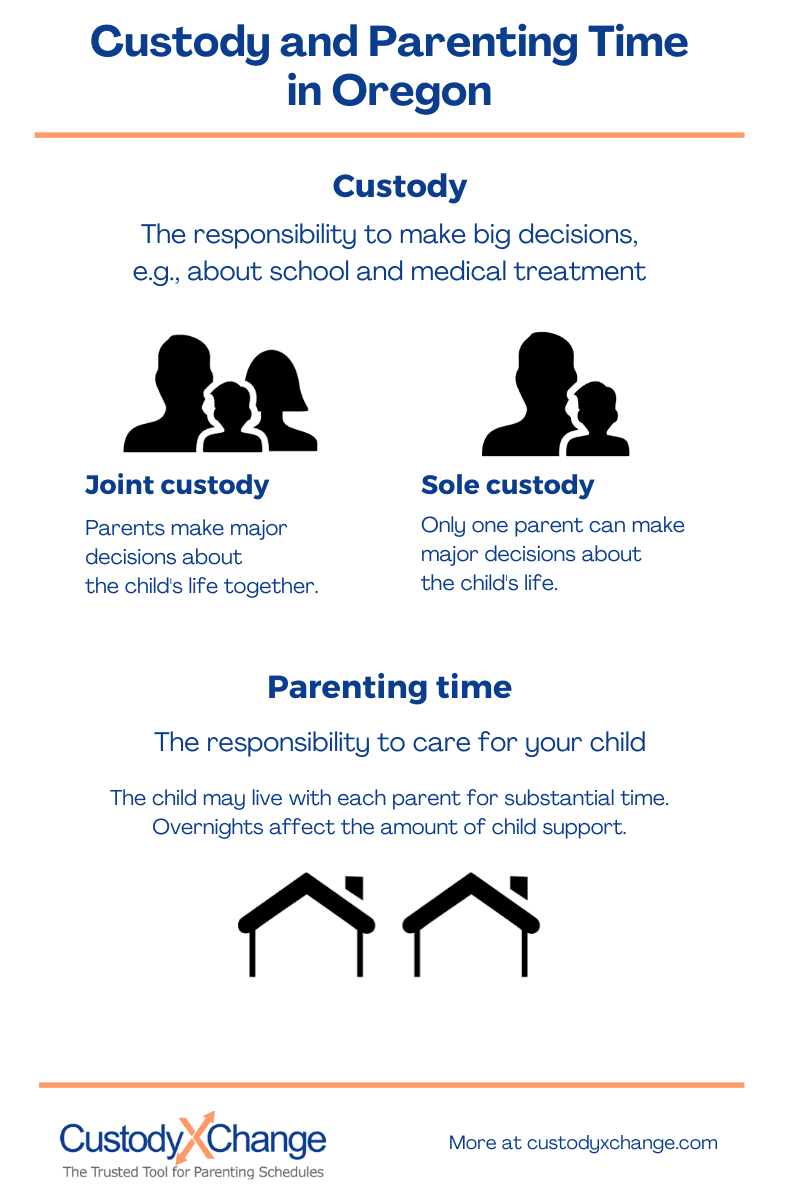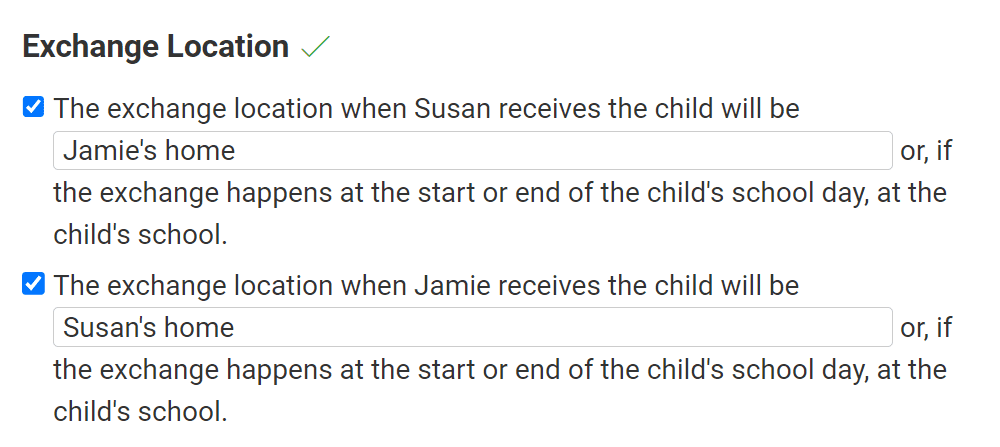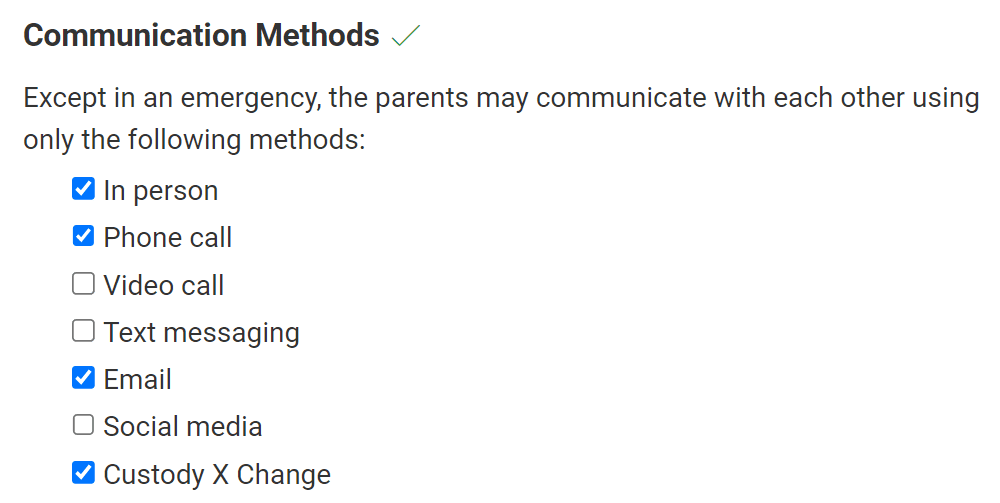Oregon Parenting Plans (Custody Agreements)
When parents file for divorce or custody in Oregon, they must propose a parenting plan to the court — together or separately.
At the end of your case, the judge will issue a court order containing a parenting plan, which addresses parenting time and decision-making. Your proposed parenting plan is a big opportunity to tell the court what you believe is best for your child.
When to submit your parenting plan
When you open your court case, you'll outline your parenting requests in your initial documents.
A more complete plan (written alone or with your co-parent) can be submitted later in the court process. Each local court may have its own timeline.
If your case is uncontested, prioritize writing your plan and submit it as early as possible. Doing so speeds up your case.
If your case is contested, bring a proposal to mediation. As long as your case is ongoing, you (or your lawyers) must attend court conferences to report your negotiation progress. As soon as you reach agreement with the other parent, submit your parenting plan to avoid trial.
How to write a parenting plan
You may use whatever format you like, as long as it includes the basic information the court requires.
Label your parenting plan with your county and the number of your court case.
Use your full names for yourselves and your child. Identify yourselves by your roles in the case: either petitioner and respondent, or else co-petitioners. Within the plan, you can refer to yourselves by names like Mother and Father, or Parent A and Parent B, as long as it's clear who's who.
Oregon provides a few sample parenting plans, including a basic form with optional extra pages for detail. You're prompted to verbally describe your parenting time schedule as part of this. Each judicial district may provide its own parenting plan template; check with your local court. Lawyers and mediators tend to have their own templates.
Many parents use the Custody X Change parenting plan template, an online tool that offers more guidance. You can print your plan for court, and you can keep your data for future reference. The app lets you easily create a visual calendar, and it can send you reminders when it's time to exchange your child.
Try this with Custody X Change.
Custody: Who makes decisions
In Oregon, custody refers to which parent makes major decisions about the child, especially healthcare, education and religion. (In other states, you'll hear the term legal custody.)
Your plan must say whether parents will have joint custody or one parent will have sole custody.
Joint custody means sharing major decision-making responsibilities. This works well for parents who communicate to resolve their parenting issues. A judge may ask them to specify an alternative dispute resolution method they'll try (at their expense) to address any future parenting dispute. This requirement helps some parents avoid court.
Sole custody means only one parent has the right to make these major decisions about the child. The other parent can still make day-to-day decisions during their parenting time.
If both parents want joint custody, the judge can order it (and is likely to do so). If either parent objects to joint custody, the judge must select one to have sole custody.
Parenting time: Who cares for the child
Parenting time (formerly called visitation) refers to the time each of you spends caring for your child. Day-to-day decisions, like whether your child has screen time, are up to the parent who has the parenting time at that moment, unless the issue is addressed in your plan. (See "sample provisions" below.)
The parent who has the majority of the time with the child is often — but not always — the custodial parent. If you want one of your homes to be considered your child's primary residence (e.g., to determine their school district), specify this in your parenting plan.
When you submit a parenting plan, you have to describe a schedule. Propose meaningful time for both parents. Courts want children to maintain a relationship with both parents when possible.
Your number of overnights will affect child support.
Once the court orders parenting time, you have to follow the order. It's OK for you and your co-parent to agree to minor changes as you go if you're cooperating for the benefit of your child. However, it's wise to keep a record of these changes in case you return to court.

Sample provisions to include
Specify how you'll work together to parent your child. These provisions are a few examples of what you might find useful.
Where and how you'll exchange your child. Will you hand over the child at home, school or somewhere else? How long will you wait if one of you is running late?
 You can customize this with Custody X Change.
You can customize this with Custody X Change.
How you and the other parent will communicate with each other. When there's a question or instruction about your child's care, will you call, text or email the other parent? Will you share a paper notebook? Or will you message each other on Custody X Change?
 You can customize this with Custody X Change.
You can customize this with Custody X Change.
How you'll be generous with parenting time you can't use. You might promise to offer time to the other parent before calling a babysitter. This is called the right of first refusal or the right of first option of child care.
 You can customize this with Custody X Change.
You can customize this with Custody X Change.
How you'll avoid returning to court. You can state that, in the event that you can't resolve a dispute directly with the other parent, you'll commit to seeking help from a professional mediator.
 You can customize this with Custody X Change.
You can customize this with Custody X Change.
If your case involves abuse
Report child abuse at a police station or through the Oregon Department of Human Services.
If there's any risk of harm to your child, including past abuse or threats, you can propose a safety-focused parenting plan to limit a parent's contact with the child. The parent with limits might have:
- Only supervised visitation (You can propose who will supervise them.)
- No overnight time
- No access to the child's school or extracurriculars
- A prohibition on drinking shortly before or during their parenting time
- A prohibition on directly contacting the child when it's not their parenting time
- A step-up plan to gradually increase their involvement as a parent
Other safety precautions that could apply to both parents include:
- Exchanging your child at public pick-up and drop-off sites
- Limiting your discussions to parenting topics
- Not physically disciplining your child
- Not keeping guns in the house
If a precaution feels important to you, add it. The more detailed your parenting plan is, the better it protects your child and helps them maintain a relationship with both parents.
If you need to change your parenting plan
Changing your court order is easier when both parents agree to the change.
With or without an agreement, the court will need your updated financial information. Consult your county's local court rules.
If you've reached an agreement (called a stipulation), submit it to the court. The judge may ask you both to appear for a hearing. Explain why you believe the new arrangement would be in your child's best interest. The judge will likely approve it.
If you haven't reached agreement, one of you can file a motion to modify custody or parenting time.
The easiest way to make a parenting plan
When you're writing a parenting plan, it's critical you use airtight language that leaves no room for interpretation. You must also be careful not to omit any information required by the court.
If you hire a lawyer, they'll write up the plan for you and ensure it meets the judge's expectations.
If you write your own plan, use technology to take guesswork out of the equation. The parenting plan template in the Custody X Change online app walks you through each step.
 You can customize this with Custody X Change.
You can customize this with Custody X Change.
The result is a professional document that demonstrates your competence as a parent from the first glance.
The easiest and most reliable way to make a parenting plan is with Custody X Change.
